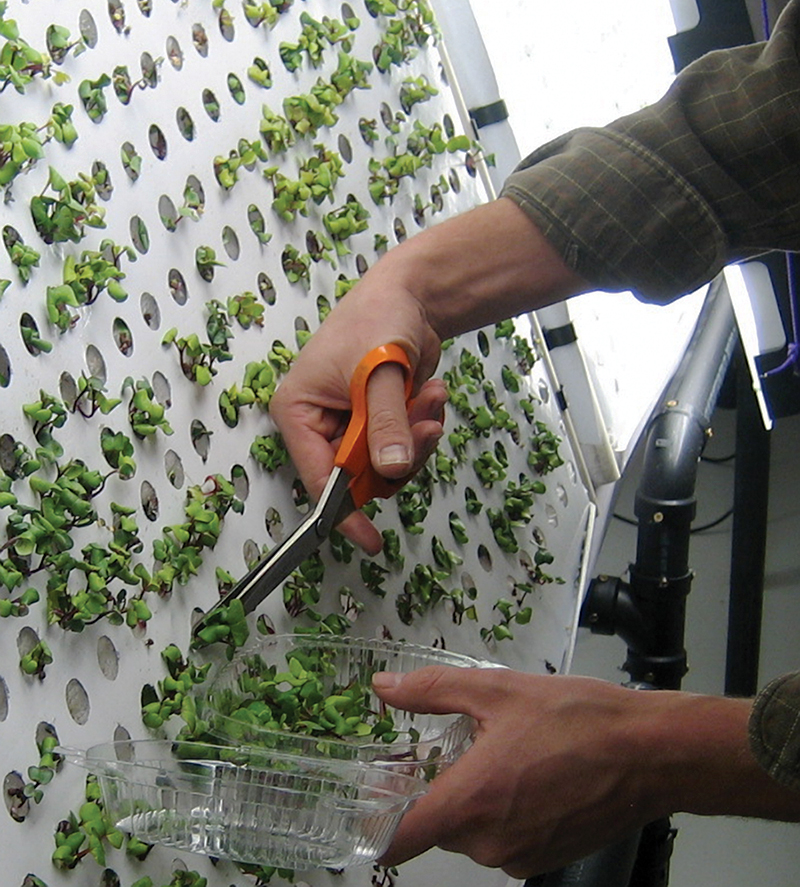
Progressive Plant Growing Has Business Blooming
Originating Technology/NASA Contribution
Soil, water, and light. According to prevailing dogma, these are the three main ingredients for growing and maintaining healthy plants. But what if you take soil completely out of the equation and limit the presence of water significantly? Can you still nurture plants in such an environment?
Call it an agricultural anomaly if you will, green thumbers, but plants are getting the tender loving care they need by way of an environmentally friendly process that is devoid of dirt and uses very little water. This process, known as aeroponics, enables plants to grow in an air/mist environment that is free from soil or an aggregate media. Though not rooted in soil, some aeroponically grown plants are actually rooted in NASA.
In 1997, AgriHouse, Inc. (d.b.a. Aeroponics International), a leading agri-biology company, united with NASA and BioServe Space Technologies, a non-profit, NASA-sponsored partnership research center, to design a soil-less plant-growth experiment to be performed in microgravity, aboard the Mir space station. This experiment aimed to gauge the effectiveness of a non-pesticide solution on the immune responses of bean plants. In essence, the research consortium was looking for a means of keeping plants free from infection, without having to rely on the use of pesticides.
This research, combined with follow-on grants from NASA, has helped Berthoud, Colorado-based AgriHouse gain credibility in the commercial marketplace with related technology and gross the capital necessary to conduct further research in a new-age field known as bio-pharming.
Partnership
Richard Stoner II, president and founder of AgriHouse, began using aeroponics in the late 1980s to grow herbs in a greenhouse. Utilizing his own patented aeroponic process, Stoner was one of the only people in the United States employing the aeroponic plant-propagating technique at the time.
Several years later, Stoner began working with Colorado State University researchers on perfecting an all-natural, organically derived, disease control liquid formula called Organic Disease Control, or Organically Derived Colloidals (ODC). This formula could cooperate with a plant’s immune system, in an aeroponic environment, to boost growth and ward off disease and infection. Dr. Jim Linden, a Colorado State University professor in the Department of Microbiology and co-inventor of the ODC technology, claimed that previous approaches by other researchers to stimulate a plant’s immune system had “fallen short of sustainable results.” He added that the newly developed ODC formula stimulates a plant’s ability to fight off diseases during its entire life cycle. News of this triumphant effort was spreading, and NASA caught wind of it.
With great interest, NASA sought Stoner’s experience in 1997 for an experiment to be carried out aboard Mir. The Space Agency immediately became interested in the low-water requirements of the aeroponic growing method. Using aeroponics to grow plants in space could reduce the amount of water carried during flight, thus, reducing the overall weight of the payload. Additionally, NASA has strict regulations concerning the use of pesticides within closed space habitats, so it was equally interested in experimenting with the ODC formula Stoner had been working on.
Stoner assented to NASA’s request for assistance, and BioServe was brought on board to help direct the research, in light of having flown a multitude of payload experiments on previous missions.
The goal of the NASA research was to determine whether or not the antifungal response of the plants was maintained during space flight. Looking at the bigger picture, the results could ultimately lead to new strategies for growing and maintaining healthy food plants on long-term space flights or for future bases on other planets and moons.
For the actual microgravity experiment, astronauts worked with adzuki bean seeds and seedlings, a high-protein Asian food crop. Along with the space-based experiment, concurrent ground control experiments were being conducted on adzuki bean seeds and seedlings back on Earth. This was done to investigate the plants’ responses in two different gravitational environments.
In general, the adzuki bean seeds and seedlings sprouted quite well both on Earth and aboard the space station. The Mir-grown seeds and seedlings, however, exhibited more growth than those grown on Earth. Though no fungal challenge was intentionally introduced into the plants, the researchers did witness fungal infection of several of the seedlings on both Earth and Mir. Preliminary visual analysis indicated that the seeds and seedlings that were treated with the ODC method grew more robustly and exhibited less fungal infection than the untreated seeds and seedlings. This was true for both flight and ground experiments. Post-biochemical analysis supported this finding and further showed that these plants retained their fungal-fighting abilities and the ODC method maintained its effectiveness in microgravity.
The success of this NASA experiment led to others, designed by Stoner and his company under numerous NASA Small Business Innovation Research (SBIR) contracts from Kennedy Space Center. Stoner took advantage of the SBIR support to create for NASA a high-performance, gravity-insensitive, enclosed aeroponic system for food production in space, as well as a low-mass, inflatable aeroponic system for rapid crop production of pesticide-free herbs, grains, tomatoes, lettuce, peppers, and other vegetables.
The high-performance, gravity-insensitive, enclosed aeroponic system can be used to produce various food crops that NASA intends to grow in space. The SBIR award contributed to the development of several methods that allow a plant’s only by-product to be the plant itself. This system is now being used by commercial growers and producers for clean, efficient, and rapid food production. Crops can be planted and harvested in the system year round without interruption, and without contamination from soil, pesticides, and residue.
The low-mass, inflatable aeroponic system has not yet been used in the Space Program, but does have potential for integration into future Moon and Mars applications. The inflatable and deflatable nature of the SBIR innovation makes it lightweight, so it takes up less volume during transportation and storage. Even more, it improves upon the preceding enclosed aeroponic system in that its design allows for a significantly larger crop yield. Spinoffs of the design and materials used are now being introduced for commercial agricultural applications.
Product Outcome
AgriHouse’s aeroponics and ODC research on Mir and its ensuing first SBIR contract made way for the commercialization of the Genesis Series V aeroponic system. With this rapid-growth system, plants can be started from cuttings from an already-mature plant placed in the openings on top of the growing chamber. The stems are suspended in this chamber. If starting with seeds, they can be placed on specially designed mesh holders that are inside of the chamber. For both the cuttings and the seeds, the resulting plants rapidly develop root systems and grow in an enclosed, air-based environment, made moist by a hydro-atomized, nutrient-rich spray that is released in timed intervals by a microcomputer and finely misted onto the growth subjects.
This clean, sterile environment greatly reduces the chances of spreading plant disease and infection that is commonly associated with other growing media. Each growing chamber has 161 openings. The grower can place one to five cuttings in each opening. Plants do not stretch or wilt while they are developing their roots. Once roots are developed, the plants can be easily removed for transplanting into any type of media without experiencing transplant shock or setback to normal growth.
The Genesis system can grow many different plant types, including nursery stock, fruits, vegetables, and houseplants. Hundreds of varieties have been cultivated by researchers, farmers, commercial greenhouse growers, and nursery operators. In the case of tomatoes, for example, growers can utilize the soil-less method to get a jumpstart on their production. Tomato growers traditionally start their plants in pots, having to wait at least 28 days before transplanting them into the ground. With the Genesis system, growers can start the plants in the aeroponic growing chamber, then transplant them to another medium just 10 days later. This advanced aeroponic propagation technology offers tomato growers six crop cycles per year, instead of the traditional one to two crop cycles. It also eliminates the need for stage one and two tissue culture transplants, thus, reducing labor and handling costs.
According to AgriHouse, growers choosing to employ the aeroponics method can reduce water usage by 98 percent, fertilizer usage by 60 percent, and pesticide usage by 100 percent, all while maximizing their crop yields by 45 to 75 percent. By conserving water and eliminating harmful pesticides and fertilizers used in soil, growers are doing their part to protect the Earth. Moreover, the NASA SBIR results demonstrated that this aeroponic technology delivers an 80-percent increase in dry weight biomass per square meter, when compared to hydroponic and soil-based growing techniques. (When a dry weight measurement is taken, all water is removed from roots, leaves, and stems—thereby, removing water from the biomass.) These results essentially proved that aeroponically grown plants uptake more minerals and vitamins compared to other growing techniques.
The high-performance crop-production technology recently reached to the other side of the world to help potato production in East Asia. With assistance from the U.S. Department of Commerce, the World Trade Center in Denver, and the Export-Import Bank of the United States, AgriHouse installed an aeroponic system at the Hanoi Agricultural University’s Institute for Agrobiology, in Hanoi, Vietnam.
According to AgriHouse, potato production in East Asia lags behind North America due to poor performance of seed potato crops. Utilizing the closed-loop features developed under the NASA grants, the company designed and installed a state-of-the-art aeroponic potato laboratory at the Institute for Agrobiology, for potato tuber seed production.
“AgriHouse’s advanced technology gives the Institute of Agrobiology the opportunity for a direct replacement of labor-intensive, in vitro tissue culture potato production,” said Dr. Nguyen Quang Thach, the institute’s director. “Furthermore, the economic impact in the region from the seed potato-production features of this NASA technology will give our underdeveloped country a tremendous boost.”
AgriHouse’s Beyond is yet another environmentally conscious, crop-boosting commercial product stemming from the Mir research and the first SBIR contract. Based on the ODC formula tested and proven in space, Beyond is considered “nature’s natural health booster for all plants” by the company. The all-natural product is derived from natural aquatic materials, and therefore contains no enzymes, hormones, petrochemicals, acids, or manure, and does not affect the natural mineral uptake of plants. As a multipurpose cure-all for any garden—no matter what growing method is used—Beyond eliminates the need for pesticides; promotes faster seed germination; increases the survival rate of seeds; revives sick or infected plants; increases growth and yields; adds natural nitrogen to soil-based flora; is 100-percent biodegradable; and has an indefinite shelf life.
Beyond is also super-concentrated, so it does not take a large application of the liquid to realize positive results. At 16 ounces, each bottle makes over 160 gallons of plant-treating solution when mixed with water. This balances out to be enough treatment for over 1 acre of field crops. In stand-alone applications of a smaller nature, such as plant revival, pre-planting, or plant-potting, users can simply pour about an ounce of the solution directly on plants, seeds, and sprouts, once or twice a week.
Beyond customers are expressing their satisfaction with the product left and right, whether it be a potato farmer who experienced a 45-percent growth rate in potato stock, or one of the thousands of shoppers who saw it for sale on the HSN shopping channel (formerly recognized as theShopping Network channel) and purchased it for domestic purposes.
AgriHouse’s most recent NASA spinoff is its Flex aeroponic system, which incorporates the lightweight material from the low-mass inflatable system that was developed for NASA during a succeeding SBIR contract. Like the Genesis system, the Flex system is a closed-loop aeroponic system. The Flex system, however, possesses a chamber that contains 1,000 plant holders, offering a tenfold increase in fresh crop production per square meter over the Genesis system. It is capable of delivering 12 growing cycles per year and eliminates the need for a greenhouse.
With an eye to the future, AgriHouse is now exploring advanced bio-pharming techniques in which natural compounds derived from botanicals may be used in place of chemicals to product pharmaceuticals. Specifically, Stoner and his company are focusing on creating controlled environments to produce bountiful crops to be used in bio-pharming.
Beyond™ is a trademark of AgriHouse, Inc.
HSN® is a registered trademark of HSN LP.
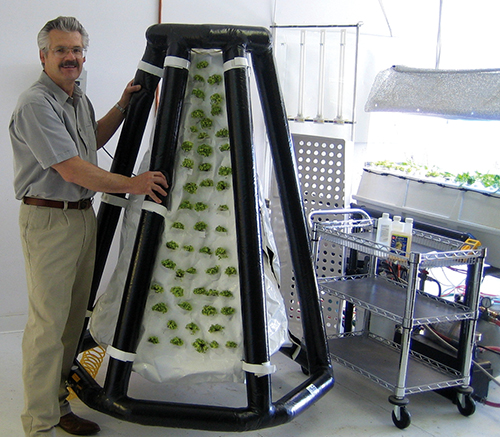
Richard Stoner II, president and founder of AgriHouse, Inc., with a prototype of the inflatable aeroponic system for space and microgravity food production.
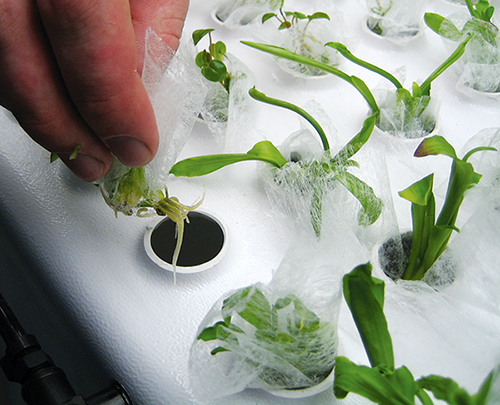
These plants have developed healthy root systems, all while growing in the soil-less environment of the Genesis Series V rapid-growth aeroponic system.
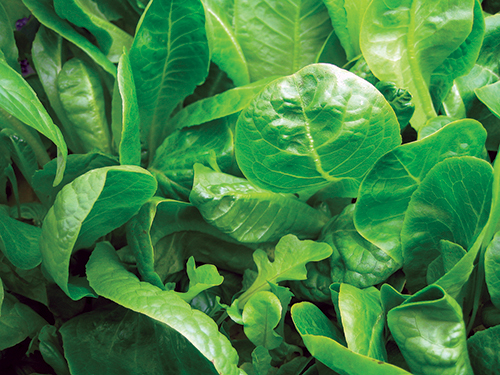
Despite the drastic reduction in water and fertilizer usage, those employing the aeroponics growing method are witnessing robust crop yields and healthy, vibrant coloring.
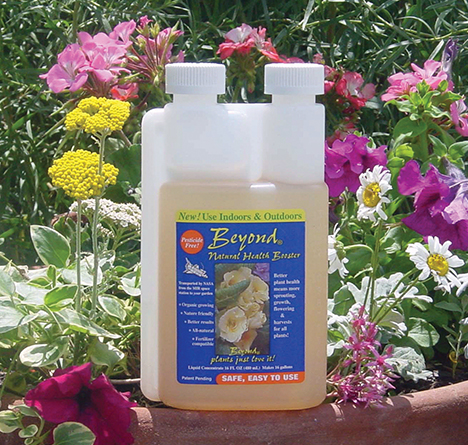
Beyond, a nature-friendly, nontoxic product that promotes faster seed germination, strengthens root systems, and increases growth and yields, all while eliminating the need for pesticides.

A grower clips the leaves of plants grown in the openings of a Genesis chamber.













